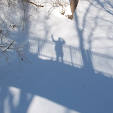The book has as its most basic thesis that agricultural societies replace hunter-gatherer societies. Hence, the development of agriculture is the most basic and fundamental economic development of history. Agriculture was independently developed in a number of places around the world. The earliest was in the Fertile Crescent of the Middle East, and from there we get wheat. In the Americas the two great centers of agricultural development were in Mexico and central American (corn, beans, squashes) and the Andes (potatoes, sweet potatoes, beans, peanuts, tomatoes, squashes).
However, there was also development of agriculture in the eastern U.S. starting around 2500BC. A local squash was developed for containers and seeds, and also a sunflower, sumpweed (a relative of the daisy), and goosefoot (a plant related to spinach). These were not enough for a completely agricultural lifestyle. The Indians still needed to gather and hunt. Around 500 BC the addition of three other crops, maygrass, little barley, and knotweed) were cultivated, and the majority of calories could be satisfied with farming.
What happened to these crops? The sunflower and the squash are still cultivated. The others dropped out of cultivation when the crops of Mexico finally made their way north. That took a while because new varieties had to be developed for the different climate. But once corn and beans arrived, most of the other crops disappeared from cultivation. Diamond writes, "No European ever saw sumpweed growing in Indian gardens because it had disappeared as a crop by the time European colonization in the Americas began, in A.D. 1492."
People plant various kinds of gardens. It would be interesting for someone to plant a garden showing what an Indian garden in the Eastern U.S. might have looked like in 100 B.C. and what it would have looked like in 1000 A.D. I doubt if there were any such gardens in Jasper County--the swampy conditions probably left it to the hunter-gatherers--but maybe there was some agriculture. Perhaps Prophetstown State Park could do something like that, since they have part of the park showing agriculture in the 1920s and another part dedicated to the Indian past. (I have complained before that we as a community ignore the long history of Indian occupation of this area.)
More information on the development of agriculture in what is now the U.S. is here, here, here, and here,




1 comment:
Fascinating! Though goosefoot, or lambsquarters (Chenopodium spp) is now considered a weed, some folks around here still eat it. Three Sisters gardens are somewhat popular. Salamonie State Reservoir, among other properties, usually plants one. But the comparison gardens you suggest would be really interesting!
Post a Comment